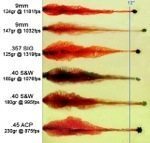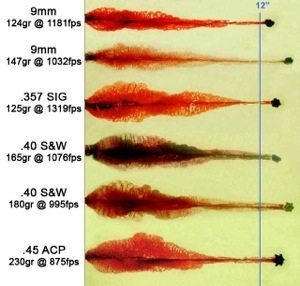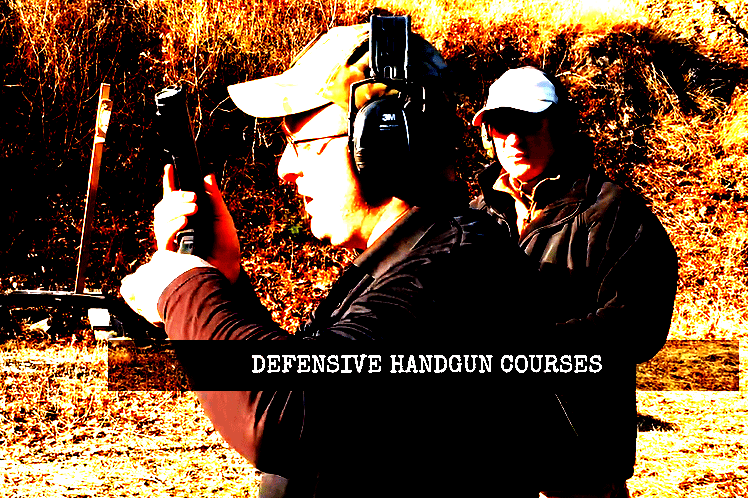
01 Sep END THE DEBATE: 9mm versus 45 ACP versus whatever…
Mine’s Bigger Than Yours
So the other day I posted up on our Facebook page the question of what caliber peopler prefer: 9mm, 40 S&W, or 45ACP with the expressed intent of essentially inciting a pissing contest to give me the opportunity to rain some knowledge down on y’all….. School circle on the Sarge for a few minutes…
There is often the misconception that bullet size is directly relative to “stopping power” in reference to the caliber’s ability to stop a threat. Let us clear up that little myth for a second here: stopping power is bullshit fed to us by ammo manufacturers to get us to buy bullets that are more gooder than their competitor’s bullets. All bullets have the potential to stop an aggressor, whether or not they do it effectively is the crux of the argument.
Here’s the post:
Now we had a few interesting responses regarding what caliber people prefer and I agree with the majority of them, or at very least can see the point of the person responding. One thing kind of stuck in my mind as something that needed to be addressed and that is this notion of kinetic energy being the cause of threat stoppage post bullet strikes. My friend and fellow Jarhead, Josh VanSteenwyk of J&J Tactical hit the proverbial 10 ring with his responses: kinetic energy has nothing to do with threat stoppage. Think about it. If a round were to be able to stop a man in his tracks it has to overcome the energy being presented by that man, while imparting an equal and opposite reaction to the person firing the shot. Anyone ever seen Mythbusters?
There is only one way that a single round is going to stop a threat every time: hitting someone in the ocular cranial cavity (technical term for face) inducing instantaneous de-animation (technical term for turning out someone’s lights). Rounds to the center mass of a target often do not stop the threat immediately. If an attacker is motivated enough and/or chemically impaired, even multiple rounds can be ineffective at immediately stopping the threat. Don’t get me wrong, enough combat effective hits on a target will stop the threat sooner than later, but nothing should be considered to be absolute. Go for the high percentage shot based on the center mass of the available target area.
Basic Ballistics
Now lets talk about wound cavities caused by different caliber handgun rounds. If you notice in the above photo, there is little difference between 9mm, 40 S&W and 45 ACP in regards to both temporary and permanent wound cavities, and overall penetration. The edge does go slightly in favor the the 45 as we see that there was quite of bit of tissue disruption within the initial 6 inches of penetration into the ballistic gelatin. What does that mean? In simple terms, more stuff got messed up by the round as it passed through. Excluding variables such as bullet deflection off of bone/clothing/etc, there appears to be a greater level of effectiveness within the desired space. Shots into the thoracic cavity are intended to have the effect of disrupting the major organs in such a way that the body simply stops functioning due to blood loss and failing circulation and/respiration. Organs are fragile and it does not take much to cause irreparable damage when a projectile passes through. All rounds go past the minimum required 12 inches of penetration so penetration really isn’t the issue.
I’m purposely trying to avoid the temporary versus permanent wound cavity issue here as it is a bit of a moot point when talking handgun rounds. (Rifle rounds are a different story) The temporary wound cavity refers to the stretching of tissue as the round passes through the body, whereas the permanent wound cavity refers to the damage left behind. Remember that little bit about bleeding out? Yup… That’s right folks, the bigger the permanent wound cavity the better. Ergo, the bigger the bullet, the bigger the permanent wound cavity. Don’t take my word for it though. Here’s what the FBI had to say in 1987:
Kinetic energy does not wound. Temporary cavity does not wound. The much discussed “shock” of bullet impact is a fable and “knock down” power is a myth. The critical element is penetration. The bullet must pass through the large, blood bearing organs and be of sufficient diameter to promote rapid bleeding. Penetration less than 12 inches is too little, and, in the words of two of the participants in the 1987 Wound Ballistics Workshop, “too little penetration will get you killed.”42, 43 Given desirable and reliable penetration, the only way to increase bullet effectiveness is to increase the severity of the wound by increasing the size of hole made by the bullet. Any bullet which will not penetrate through vital organs from less than optimal angles is not acceptable. Of those that will penetrate, the edge is always with the bigger bullet.44
Click here for the full document
Once again, there is no magic bullet and a 9mm… hell even a .22 is better than no gun in hand when involved in a lethal force situation. Threats are stopped by three things: disrupting the Central Nervous System, causing massive blood loss/permanent tissue disruption, or denying mobility (taking the legs out from underneath the threat). Nothing is guaranteed so shoot to stop.
My personal preference goes to the 45 as years of carrying one on duty and thousands of rounds in training have made me very comfortable with the caliber. I like the softer recoil impulse of the 45 as compared to the 40 S&W and prefer the ballistics over a 9mm. But that’s just my opinion. Take it for what it’s worth.
Having stated the above, logic dictates that you should bring as many rounds to the party as is reasonable. Bring a reload or three. You never know when the zombie hordes will be lurching up your street hell bent on smearing your brains on a Ritz cracker for a midnight snack. (Insert Zombieland references here)
That being said, logic also dictates that in areas where the powers that be have restricted our freedoms to ten rounds or less, bring the bullet that will have the greatest ballistic effect on the target. We can’t EDC a 12 gauge with rifled slugs here in Massachusetts so my M&P45 with 180gr JHP +P loads rides my hip. Add in a spare magazine and we have 21 total rounds on board. Would I like more, yup. Situations don’t always allow for it but my bailout bag has another 2 mags in conjunction with some Active Shooter Response equipment. (Review on that to follow)
Enough Already!!
Bottom line is this folks: train with what you have until you can effectively place multiple shots in combat effective zones. More importantly, never be satisfied with your level of accuracy. Always train and seek to improve. Seek instruction (we know some guys who can help) and NEVER be absolute.
And stop the madness when it comes to which bullet is better. Getting shot with anything sucks. You could also get hit by a bus. Cease the pissing contests on the interwebz and get on the range.
Don’t forget to share this post, follow our blog, and like our Facebook page for more great content!
DISMISSED.
– Rob
Please fill out a contact form below with any outstanding questions you may have!
Error: Contact form not found.







Rich
Posted at 07:08h, 05 September“If you notice in the above photo, there is little difference between 9mm, 40 S&W and 45 ACP in regards to both temporary and permanent wound cavities,”
Uhh no the .40 and .45 clearly had MUCH bigger wound cavities.
M. Grawe
Posted at 05:47h, 25 DecemberThe FBI went back the 9mm to accomodate an anticipated increased enrollment for lady field agents that the Obama administration wanted, pure and simple! Physical requirements and qualifying with a fire arm are the ladies two biggest obstacles to overcome in the military as well as in the FBI! There will always be those that disagree, but the fact still remains that the FBI threw away 40 years on their 10 mm project starting back in 1968 to replace the deficient 9 mm! If they were wrong then, they’re probably wrong now, along with the fact that there is’nt much collateral support for their recent change of heart! …then why not the .380?
NAC
Posted at 13:42h, 20 AprilAgree then why not move to the 5.7×28 if we are going to talk less recoil higher cap weapons and also it will go through a vest.
MattD
Posted at 19:23h, 02 JunePlease consider reporting on the statistics relating to hits/misses and shot placement by caliber rather than bullet effectiveness.
I have a pretty good idea what the effectiveness of a missed or less than optimally placed shot is.
If rather have one well placed .45 acp hit than 15 spray and prays.
Danny Smith
Posted at 17:26h, 27 June1) “There is often the misconception that bullet size is directly relative to “stopping power”
No misconception here…weight, mass and velocity (assuming good shot placement) decide the so-called stopping power.
2) “Kinetic energy does not wound. Temporary cavity does not wound. The much discussed “shock” of bullet impact is a fable and “knock down” power is a myth.”
This is laughable, where are you getting this bullshit…from a Steven Seagal movie?! The simple fact is, a projectile passing through or into a body will “wound” and there will be bleeding. How much depends on a lot of factors that can’t be figured out by shooting blocks of gelatin or playing with ballistic tables on a computer.
Retired Soldier, 17 + year Cop
Kyle Odom
Posted at 23:47h, 09 OctoberThere are a lot of things that are hard to get your noodle around in terminal balistics, but they are important nonetheless.
1. Kinetic energy is not a wounding mechanism, it is POTENTIAL that is all.
2. Shot placement and number of holes is more important than caliber.
3. Bullet design is far more important than foot/pounds of energy.
mike hansen
Posted at 02:06h, 25 JanuaryThe thing I look for in a bullet is the ability to go through a rib. Any bullet that strikes straight on in the soft space between the eyebrows and tops of the roots of the teeth will hit brain matter that will end the fight (brain stem. AK47 rounds will bounce off of teeth at a nearly 85 degree angle and go out through the cheek – several of our guys in Iraq found that out. Getting someone to hold still so you can put that round on target is the issue. So you need to shoot center of mass until the target takes a pause to realize, “I just got shot!” Then put one in the noodle. BUT if the bullet won’t go through a rib, it’s not likely to hit the heart or lungs. I’ve fought with broken ribs. It sucks, it hurts but it doesn’t stop you. Ballistic gel DOES NOT help to predict the effectiveness of a bullet. You have to put a realistic bone in the way to see if it bounces off. Many 9mm will get moved clear out of the way by bone (how many of us know guys that got shot in the forehead with a 9mm and it went in, deformed and then traveled under the skin but over the cranium to exit the back of the head? My hand is up). The key has and always will be what happens with bone. Coroners will tell you that only .40 and .45 have one shot kills only because the 9mm most bad guys use are FMJ. But a good JHP 9mm will punch through bone. Guess which ones…
John Monaghan
Posted at 17:08h, 27 OctoberWould like to see a ballistic Gelatin penetration test with the Buffalo Bore 45ACP 255 grain hard cast. I gather that the 9mm 147 grain hard cast is a good penetrator. A fishing guide in Alaska put one clear through a fairly large grizzly.
steven dent
Posted at 16:30h, 18 FebruaryI liked the article and look forward to more
Dave Wilson
Posted at 16:43h, 03 JulyClarifying the physics, I must correct the fact that potential energy is a measured amount of energy that, given no outlier or influence outside the system, tells the maximum amount of energy POSSIBLE (that is, it HAS NOT taken place yet) You are still aiming but as of yet to pull the trigger. Once the trigger is pulled it becomes Kinetic energy. Kinetic energy is equivalent to the amount of work done to accelerate a stationary object to a certain speed. Once it has reached that speed, the object retains that amount of kinetic energy until that energy transforms into heat (from friction), gravitational potential energy (from moving against gravity), or other types of energy., Given that all of those joule’s(work being done) foot/pounds or BTU British thermal units) Yes those are all one in the same are released in an area with a diameter of 4 to 6 inches you best believe that kinetic energy in the thousands of joules has excellent odds
of at least neutralizing the threat. In my opinion getting shot even in the thigh or glutes Maximus with a chunk of metal as large as the. 45acp is always going to cause substantial bleeding and in most cases if not fatal will most assure cause shock, which renders thug in question absolutely helpless. Final point… ALL SCIENCE COUNTS. THE NUMBERS DON’T LIE. Don’t take my word for it have fun with these physics equations and setup your own scenerios.
Best of Luck,
Dr. Dave Wilson Jr., self taught mathematics and Newtonian Physics Phd